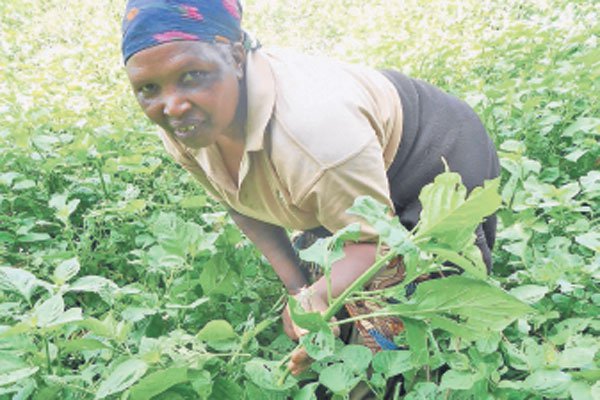Managu (Solanum nigrum), also known as African nightshade, is one of Kenya’s most cherished traditional vegetables, loved for its rich nutritional and medicinal benefits. Known for its slightly bitter taste, managu is packed with vitamins (A, C, and K), antioxidants, iron, calcium, and other vital nutrients. These attributes make it a staple in many Kenyan households and a crucial element in the local food system. As consumer awareness around indigenous vegetables continues to grow, so does the demand for managu in both local markets and high-end grocery stores. This article delves into the details of managu farming in Kenya, exploring how farmers can profit from growing this versatile and fast-growing crop.
Varieties of Managu Grown in Kenya
In Kenya, two main varieties of managu are commonly grown:
- Solanum villosum: This variety is recognized for its elongated leaves and orange berries. It is more common in rural areas where subsistence farming is practiced.
- Solanum scabrum: Characterized by broad leaves and purple berries, this variety is more widely cultivated due to its high yield and market demand.
Both varieties thrive under similar environmental conditions, but Solanum scabrum is often preferred for commercial farming due to its larger leaves, which are more desirable for consumers.
Ecological Requirements for Managu Farming
Managu is a hardy crop that can be grown in a range of environments. However, for optimal growth and maximum yields, it is essential to meet the following ecological requirements:
- Soil: Well-drained, aerated soils with high water retention capacity are ideal for growing managu. The soil should be rich in organic matter and have a pH range of 5.5 to 6.8. Applying organic manure such as compost or animal waste enhances soil fertility and boosts yields.
- Temperature: Managu thrives in moderate temperatures, ranging between 18-30°C. Excessively hot or cold conditions may affect growth and yield.
- Rainfall: Although managu is drought-tolerant, it requires moderate rainfall to flourish. The crop benefits from consistent moisture, especially during its early stages of growth. Areas with well-distributed rainfall or access to irrigation are best suited for managu farming.
Propagation and Planting
Managu can be propagated through two primary methods: direct sowing of seeds and nursery propagation.
(i) Direct Sowing
In this method, seeds are planted directly into the field. The process begins by preparing rows with a spacing of 30 cm between each row, and furrows should be 1-2 cm deep. Seeds are mixed with light soil and organic manure to enhance germination. The seeds are then sown into the furrows and covered lightly with soil. This method is faster and less labor-intensive.
(ii) Nursery Propagation
Alternatively, seeds can be raised in a nursery bed before transplanting. To do this:
- Loosen the soil in the nursery bed.
- Mix the seeds with ash or sand and sow them either by broadcasting or in rows spaced 15-20 cm apart.
- Erect a small shade over the seed bed to protect the seedlings from direct sunlight, and mulch the bed with grass to retain moisture.
- After 1-2 weeks, the seeds will germinate. Once the seedlings have developed six leaves and reached a height of 10-15 cm, they are ready for transplanting into the main field, usually after about six weeks.
Farm Management Practices
Efficient farm management is essential for a successful managu farming venture. Below are key management practices:
- Weeding: Regular weeding should be done to reduce competition for nutrients and water. Keeping the farm weed-free also helps prevent pests and diseases.
- Thinning: About four weeks after planting, thinning should be carried out to ensure proper spacing and prevent overcrowding. This practice promotes healthy plant growth and disease control.
- Pest and Disease Management: Like other crops, managu is vulnerable to pests such as aphids, spider mites, and root knot nematodes. Common diseases include bacterial wilt, powdery mildew, and fusarium wilt. Farmers can manage these threats using organic or inorganic pesticides, crop rotation, and maintaining high levels of hygiene on the farm.
Harvesting Managu
Managu is typically ready for harvest between 8-10 weeks after planting. Farmers can choose to either uproot the entire plant or harvest the tender stems, depending on market preferences. Regular harvesting of tender leaves and stems encourages new growth, extending the harvesting period for several weeks.
The Lucrative Market for Managu in Kenya
Managu enjoys a robust market in Kenya due to its rising popularity as a healthy, traditional vegetable. The crop is a common feature in open-air markets, supermarkets, and grocery stores. The rise in health-conscious consumers and the increasing shift towards organic foods has further boosted demand.
Target Markets
- Open-Air Markets and Mama Mboga Stalls: These are the most accessible and widespread markets for managu. Local sellers, including the ubiquitous “mama mboga,” sell managu to daily shoppers in residential areas.
- Supermarkets and Grocery Chains: With the growing popularity of organic and indigenous vegetables, supermarkets such as Naivas, Carrefour, and Chandarana stock managu. Farmers with larger quantities can supply directly to these retailers.
- Hotels and Restaurants: Many hotels, especially those focusing on Kenyan cuisine or health-conscious dining, have incorporated managu into their menus. Establishing supply relationships with such institutions can offer consistent revenue streams.
- Institutions: Schools and hospitals are also potential markets for managu. These institutions purchase fresh produce in bulk, providing a stable market for farmers.
Profitability of Managu Farming
Managu farming offers relatively low entry barriers and high profitability, especially when managed well. It is a fast-growing crop, meaning farmers can enjoy multiple harvests in a single season. Additionally, the low cost of inputs (mainly organic manure and seeds) makes managu farming an attractive option for small-scale farmers.
For those looking to scale up, managu can be grown in greenhouses or under irrigation systems to ensure year-round production. With proper crop management, a single acre of managu can yield a substantial harvest, with prices fluctuating between Ksh 50 to Ksh 100 per kilogram depending on the season and market demand.
Managu farming presents a promising opportunity for both subsistence and commercial farmers in Kenya. Its nutritional benefits, coupled with the growing demand for indigenous vegetables, make it a profitable crop. With proper farm management practices, pest control, and timely harvesting, farmers can consistently supply this highly sought-after vegetable to various markets, ensuring a steady income throughout the year. Whether for home consumption or commercial purposes, managu farming remains one of the best options for those looking to invest in Kenya’s agribusiness sector.





